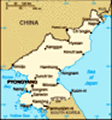Korean Government, North Korea Government
Advertisement
Country name: Conventional long form: Democratic People's Republic of Korea conventional short form: North Korea local long form: Choson-minjujuui-inmin-konghwaguk local short form: none note: the North Koreans generally use the term "Choson" to refer to their country abbreviation: DPRK
Government type: Communist state one-man dictatorship
Capital: Pyongyang
Administrative divisions: 9 provinces (do, singular and plural) and 4 municipalities (si, singular and plural) : provinces: Chagang-do (Chagang), Hamgyong-bukto (North Hamgyong), Hamgyong-namdo (South Hamgyong), Hwanghae-bukto (North Hwanghae), Hwanghae-namdo (South Hwanghae), Kangwon-do (Kangwon), P'yongan-bukto (North P'yongan), P'yongan-namdo (South P'yongan), Yanggang-do (Yanggang) : municipalites: Kaesong-si (Kaesong), Najin Sonbong-si (Najin), Namp'o-si (Namp'o), P'yongyang-si (Pyongyang)
Independence: 15 August 1945 (from Japan)
National holiday: Founding of the Democratic People's Republic of Korea (DPRK), 9 September (1948)
Constitution: Adopted 1948; completely revised 27 December 1972, revised again in April 1992, and September 1998
Legal system: Based on German civil law system with Japanese influences and Communist legal theory; no judicial review of legislative acts; has not accepted compulsory ICJ jurisdiction
Suffrage: 17 years of age; universal
Executive branch: Chief of state: KIM Jong Il (since July 1994); note - on 3 September 2003, rubberstamp Supreme People's Assembly (SPA) reelected KIM Jong Il Chairman of the National Defense Commission, a position accorded nation's "highest administrative authority"; SPA reelected KIM Yong Nam President of its Presidium also with responsibility of representing state and receiving diplomatic credentials; SPA appointed PAK Pong Ju Premier head of government: Premier PAK Pong Ju (since 3 September 2003); Vice Premiers KWAK Pom Gi (since 5 September 1998), JON Sung Hun (since 3 September 2003), RO Tu Chol (since 3 September 2003) cabinet: Cabinet (Naegak), members, except for the Minister of People's Armed Forces, are appointed by the SPA elections: election last held in September 2003 (next to be held in September 2008) election results: KIM Jong Il and KIM Yong Nam were only nominees for positions and ran unopposed
Legislative branch: Unicameral Supreme People's Assembly or Ch'oego Inmin Hoeui (687 seats; members elected by popular vote to serve five-year terms) elections: last held 3 August 2003 (next to be held in August 2008) election results: percent of vote by party - NA; seats by party - NA; ruling party approves a list of candidates who are elected without opposition; some seats are held by minor parties
Judicial branch: Central Court (judges are elected by the Supreme People's Assembly)
Political parties and leaders: Major party - Korean Workers' Party or KWP [KIM Jong Il, general secretary]; minor parties - Chondoist Chongu Party [RYU Mi Yong, chairwoman] (under KWP control); Social Democratic Party [KIM Yong Dae, chairman] (under KWP control)
Political pressure groups and leaders: None
International organization participation: ARF, FAO, G-77, ICAO, ICRM, IFAD, IFRCS, IHO, IMO, IOC, ISO, ITU, NAM, UN, UNCTAD, UNESCO, UNIDO, UPU, WFTU, WHO, WIPO, WMO, WToO
Diplomatic representation in the US: None; North Korea has a Permanent Mission to the UN in New York
Diplomatic representation from the US: None (Swedish Embassy in Pyongyang represents the US as consular protecting power)
Flag description: Three horizontal bands of blue (top), red (triple width), and blue; the red band is edged in white; on the hoist side of the red band is a white disk with a red five-pointed star
Advertisement
The information here has been derived from Public Domain Sources such as the CIA World Factbook. No liability can be taken for any inaccuracies.
Tot: 0.031s; Tpl: 0.007s; cc: 3; qc: 8; dbt: 0.0088s; 1; m:domysql w:travelblog (10.17.0.13); sld: 1;
; mem: 1.1mb

 An independent kingdom under Chinese suzerainty for most of the past millennium, Korea was occupied by Japan in 1905 following the Russo-Japanese War; five years later, Japan formally annexed the entire peninsula. Following World War II, Korea was sp...
An independent kingdom under Chinese suzerainty for most of the past millennium, Korea was occupied by Japan in 1905 following the Russo-Japanese War; five years later, Japan formally annexed the entire peninsula. Following World War II, Korea was sp...
